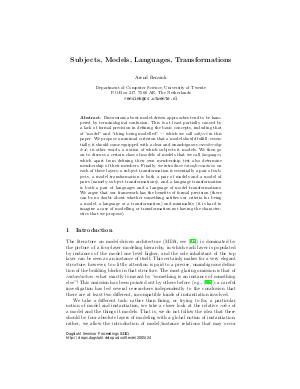Subjects, Models, Languages, Transformations
Author Arend Rensink
-
Part of:
Volume:
Dagstuhl Seminar Proceedings, Volume 4101
Part of: Series: Dagstuhl Seminar Proceedings (DagSemProc) - License:
 Creative Commons Attribution 4.0 International license
Creative Commons Attribution 4.0 International license
- Publication Date: 2005-02-07
File

PDF
DagSemProc.04101.14.pdf
- Filesize: 215 kB
- 13 pages
Document Identifiers
Subject Classification
Keywords
- no keywords
Metrics
- Access Statistics
-
Total Accesses (updated on a weekly basis)
0Document
0Metadata
Abstract
Discussions about model-driven approaches tend to be hampered by terminological confusion. This is at least partially caused by a lack of formal precision in defining the basic concepts, including that of \model" and \thing being modelled" | which we call subject in this paper. We propose a minimal criterion that a model should fulfill: essentially, it should come equipped with a clear and unambiguous membership test; in other words, a notion of which subjects it models. We then go on to discuss a certain class of models of models that we call languages, which apart from defining their own membership test also determine membership of their members. Finally, we introduce transformations on each of these layers: a subject transformation is essentially a pair of subjects, a model transformation is both a pair of models and a model of pairs (namely, subject transformations), and a language transformation is both a pair of languages and a language of model transformations. We argue that our framework has the benefits of formal precision (there can be no doubt about whether something satifies our criteria for being a model, a language or a transformation) and minimality (it is hard to imagine a case of modelling or transformation not having the characterstics that we propose).
Cite As Get BibTex
Arend Rensink. Subjects, Models, Languages, Transformations. In Language Engineering for Model-Driven Software Development. Dagstuhl Seminar Proceedings, Volume 4101, pp. 1-13, Schloss Dagstuhl – Leibniz-Zentrum für Informatik (2005)
https://doi.org/10.4230/DagSemProc.04101.14
BibTex
@InProceedings{rensink:DagSemProc.04101.14,
author = {Rensink, Arend},
title = {{Subjects, Models, Languages, Transformations}},
booktitle = {Language Engineering for Model-Driven Software Development},
pages = {1--13},
series = {Dagstuhl Seminar Proceedings (DagSemProc)},
ISSN = {1862-4405},
year = {2005},
volume = {4101},
editor = {Jean Bezivin and Reiko Heckel},
publisher = {Schloss Dagstuhl -- Leibniz-Zentrum f{\"u}r Informatik},
address = {Dagstuhl, Germany},
URL = {https://drops.dagstuhl.de/entities/document/10.4230/DagSemProc.04101.14},
URN = {urn:nbn:de:0030-drops-242},
doi = {10.4230/DagSemProc.04101.14},
annote = {Keywords: no keywords}
}
